This article was co-authored by Bryan Villella. Bryan Villella is the Lead Firearms Instructor and Owner of Don't Be A Sitting Duck in Kissimmee, Florida. Bryan has nine years of professional experience and is an NRA and Florida State Certified “K” Instructor. He leads certified training courses necessary to get licensed through the state to work in the private security field. He prioritizes safety and building comfortable environments for people to learn skills safely.
There are 14 references cited in this article, which can be found at the bottom of the page.
wikiHow marks an article as reader-approved once it receives enough positive feedback. This article has 12 testimonials from our readers, earning it our reader-approved status.
This article has been viewed 1,369,354 times.
Despite what Hollywood would have you believe, shooting a handgun with precision requires balance, technique, and practice. Even if you're an experienced shooter of long guns, shooting a handgun accurately requires a different set of skills. Read on for a basic primer on handgun safety and accuracy.
Things You Should Know
- Protect yourself with earplugs and safety goggles. Remember to always stay aware of your surroundings when you're shooting a gun.
- Hold the gun in your dominant hand and steady the gun with your free hand.
- Face your target and stand with your feet shoulder-width apart. Take a step forward with your non-dominant foot to stagger your stance.
- To aim, align the front sight with the rear sight until the target comes into focus. Pull the trigger slowly in one smooth, controlled motion.
Steps
Learning Basic Handgun Skills
-
1Learn the difference between a revolver and a semi-automatic pistol. These are the two basic types of handguns. The handguns you would see in a cowboy movie are revolvers. The cartridges in a revolver are loaded into a cylinder in the middle of the frame of the gun. A capacity of six is most common but some hold five and are designed to fit smaller hands. A semi-automatic pistol has a sliding mechanism at the top of the handgun and a magazine of pre-loaded ammunition in the handle. Operation of each type of handgun differ slightly so it's important to clearly define terms before handling a gun.[1]
- Revolvers have a revolving cylinder for holding the ammunition. The ammunition is loaded into the cylinder, then the cylinder swings into the revolver and it is ready to fire. After a bullet is fired, the cylinder rotates and lines up the next cartridge in line with the firing pin. Most revolvers can be fired in a double action mode which is pulling the trigger which rotates the hammer until it falls and fires the cartridge. Additionally, the hammer can be pulled back into position before the trigger is pulled, this results in a much lighter trigger pull and improves accuracy. In order to retrieve the spent cartridges, the cylinder is rotated outwards allowing the empty ammunitions to be removed.[2]
- A semi-automatic pistol advances each cartridge into the chamber from the magazine. It then ejects the empty cartridge after it has been fired. The slide on the top of the gun is used to advance the first shell into the chamber, and can be locked in the back position with a button or pin on the side. The removable magazine is removed and loaded separately.
-
2Choose the right handgun and ammunition for your needs. Handguns come in many varieties with a seemingly endless array of ammunition options. Also, consider your body, hand size and purpose of your handgun to find one that's comfortable for you to shoot.[3]
- You probably don't need a .357 Magnum to try out target shooting at the gun range. Avoid buying an overly large high-caliber gun if you're interested in getting started, and instead get a small-caliber reliable gun, like a .22. Talk to dealers and others experienced with firearms for recommendations.
Advertisement -
3Protect your ears and eyes with proper safety gear. Headphone-style ear protection and earplugs will protect against the noise of the gunshots. Safety goggles will protect the eyes from flying shells, hot gasses and lead particles that are ejected from a semi-automatic handgun.[4]
- Wear safety goggles even if you already wear glasses. Safety goggles are designed to protect you in a way your glasses won't.
-
4Always handle a handgun safely. When handling a handgun, always keep it pointed downrange. Do not use a gun range unless there is an appropriate backdrop and safety equipment.[5]
- Be careful of all safety consideration while at the range. It is not only important to practice good gun safety, you must be aware of what those around you are doing. Many beginners struggle pulling the slide back with a semi-automatic with just their thumb and forefinger, especially if the handgun has a strong spring or your hands are sweaty. If you need to use the palm of your hand (or your whole hand) to pull back the slide, turn your body sideways to the weapon and keep it pointed downrange.
Holding the Handgun
-
1ALWAYS check first to see if the handgun is loaded. ANY time you pick up a handgun you need to check to see if it is loaded.[6] Even when you first bring it home from the store, check to see if it is loaded. If you got it out of the closet for the first time in ten years, check to see if it is loaded. If you just unloaded it, check to see if it is loaded. And, always check any gun that is given to you by anybody at anytime. Failure to do this can result in serious damage to property, injury to people and death!
- With a revolver, release the cylinder and rotate it to the side. All the chambers should be empty. In a semi-automatic pistol, remove the magazine from the gun and pull the slide back to look into the chamber to make sure there isn't a cartridge in the firing chamber. If there is, racking the slide should eject it.
- Keep the slide in the back position while you practice holding the gun to be sure it's unloaded and to get used to keeping your thumb out of the way of the slide's action.
-
2Carefully pick up your gun, keeping your finger outside the trigger guard, extended straight and flat on the side of the guard. Whenever you handle it, make sure the barrel is pointed downrange, which should be clear of people. Outdoors, always keep your handgun pointed downwards, never up. A bullet fired up by accident will come down and may injure someone.
- NEVER point any gun at anyone even if it is unloaded, and even as a joke. Pointing a gun at someone is a crime in some states and the stupidest thing you can ever do. There will be times you believe it to be unloaded when it is. Practice holding the gun at the range with the gun unloaded.
-
3Hold your weapon in the firing-ready position.[7] Open your dominant hand (the hand you write with) to expose the webbing between your index finger and thumb. Taking the pistol in your other hand, insert the grip (handle) of the pistol into the web of your dominant hand. With your thumb on one side of the grip, keep your middle, ring, and pinky fingers curled securely around the other side just below the trigger guard.
- You are really gripping the gun only with the middle and ring fingers, the "pinky" is resting on the gun but is not used to grip; neither is the thumb used to grip the gun. The grip should be firm but not tight. If you're gripping it so tightly that the gun shakes, you will not be able to accurate control it.
-
4Steady the gun with your other hand. Your non dominant hand should be held underneath the handgun providing support for the weight of the gun. Place your index finger on the bottom of the trigger guard or in front of it, wherever is most comfortable.
-
5Make sure all fingers are clear of the slide or hammer. Some older semi automatics have a habit of 'biting' the web between your index finger and thumb. Getting "bitten" by the slide can be very painful as well as dangerous, because you don't want to react to pain and risk dropping a loaded and cocked gun with the safety off.[8]
-
6Stand in the proper firing stance. Your feet should be shoulder-width apart, with the foot opposite your dominant hand about a step past the other foot. Lean forward slightly with your knees bent, making sure you’re firmly balanced. The elbow of your dominant arm should be almost straight and your non-dominant elbow should be flexed at a slightly obtuse angle. Your dominant arm must be in line with the handgun and pointed at the target.[9]
- Some shooting matches are done one-handed (off hand). In those events, the stance is more "open" with the gun arm and the body in almost a straight line to as much as about 90-degrees, the dominant foot toward the target. A firm grip on the gun is more important since you are not using the other hand for support.
- Never aim the gun sideways or with a bent wrist like in the movies. This is extremely dangerous and unsteady!
Aiming the Gun
-
1Align the front sight with the rear sight. Ensure that the top of the front sight post is level with the top of the rear sight, and that the rear sight appears evenly centered within the notch of the front sight. This will ensure that the gun is level and that you'll get a good "sight picture" when aiming at the target.[10]
- It is most common to aim by using your dominant eye and closing the other. For other events where depth perception is important, practice aiming with both eyes open. You will need to learn to ignore the picture from your non dominant eye while still seeing the depth.
-
2Develop your sight picture. When shooting, a common confusion is where to focus.[11] On the target? On the sight? On the target? After leveling the handgun and ensuring your firearm is aimed correctly you will need to focus on the target or placing your shot accurately is impossible.
-
3Fix the gun on the target. You should see the sharply focused front sight touching the bottom of the blurry, unfocused bulls-eye. Now you place your trigger finger on the trigger.
-
4Load the gun. When you're ready to shoot and you've practiced aiming and steadying the gun and developing a good sight picture, load the gun. Keep the safety on when loading the gun (if your gun has one) and remove it when you're in the firing position with your gun pointed at the target. Keep the barrel of the gun pointed downrange the entire time you load the gun! Most shooting accidents happen during loading and unloading a handgun.
- If the pistol is a semi-automatic, you'll need to load a round into the chamber by pulling back the slide and releasing it.
Firing the Gun
-
1Control your breathing. Shortly before firing the handgun, after you have carefully aimed it, you will need to take a deep breath and hold it. Calm your body. Looking at how the sights will be moving, you will notice that it traces a small figure eight pattern. This is due to the beating of your heart. In order to ensure you can see your aim point, pull the trigger when the sights come to the bottom of the figure eight. By the time you are finished pulling the trigger, the sights should be at the aim point. From the time you hold your breath to the time you pull the trigger should be short but not rapid or hurried.[12]
-
2Pull the trigger. Every firearm has a different trigger pull - the amount of pressure required for it to fire. Before you load the handgun, it's a good idea to "dry fire" the handgun, (point the gun down range and pull the trigger while the gun is unloaded). This will help you learn what point in the trigger pull the gun will fire. When you are ready to fire, pull the trigger slowly in one smooth, controlled motion. A common reason for inaccurate shots is trying to anticipate the recoil (jerking the gun right as you think it's going to fire). It may seem counter-intuitive, but for the most accurate shots, try to let the recoil "surprise you" rather than predicting when it will happen.
-
3Follow through. Every sport has "follow-through" and target shooting is no exception. As you squeeze the trigger the gun will fire, but don't release the trigger suddenly or relax your posture, your stance or your arms. Be still. Release the trigger after you've taken a breath and prepare for the next shot.
- Follow-through action improves accuracy and reduces shot variation, just as follow-through does for a golfer or a tennis player.
-
4Practice firing several rounds. Take your time between rounds. There is no hurry.It is better to get a few accurate hits than to get many bad shots. You are at the range to get better, not turn money into noise.
-
5Unload your weapon and recheck it to ensure it is unloaded. With the gun still in firing position, click the safety back in place (if your handgun has one) and remember to keep the gun pointed downrange while you unload it. For revolvers, check the cylinder to ensure there are no rounds in it or remove any that are. Release the magazine from a semi-automatic pistol and rack the slide to eject any shells that may be in the chamber.
- Go to a gun range as frequently as you're able to so you can keep practicing and improving your shooting skills.
Expert Q&A
-
QuestionIs shooting a gun in the air illegal?
 Bryan VillellaBryan Villella is the Lead Firearms Instructor and Owner of Don't Be A Sitting Duck in Kissimmee, Florida. Bryan has nine years of professional experience and is an NRA and Florida State Certified “K” Instructor. He leads certified training courses necessary to get licensed through the state to work in the private security field. He prioritizes safety and building comfortable environments for people to learn skills safely.
Bryan VillellaBryan Villella is the Lead Firearms Instructor and Owner of Don't Be A Sitting Duck in Kissimmee, Florida. Bryan has nine years of professional experience and is an NRA and Florida State Certified “K” Instructor. He leads certified training courses necessary to get licensed through the state to work in the private security field. He prioritizes safety and building comfortable environments for people to learn skills safely.
Lead Firearms Instructor Yes, and it is also very reckless. This is extremely dangerous, because what goes up must come down, and you should always be accountable for every round that comes out of your gun.
Yes, and it is also very reckless. This is extremely dangerous, because what goes up must come down, and you should always be accountable for every round that comes out of your gun. -
QuestionFor example, is there any way I can get hurt firing a revolver for the first time?
 Community AnswerKeep your fingers away from the front of the cylinder, hot gasses escape around the forcing cone when the revolver is fired. Don't point the gun at yourself or anything else you're not willing to destroy. Don't shoot at anything that may become angry with you like a large animal.
Community AnswerKeep your fingers away from the front of the cylinder, hot gasses escape around the forcing cone when the revolver is fired. Don't point the gun at yourself or anything else you're not willing to destroy. Don't shoot at anything that may become angry with you like a large animal. -
QuestionHow do I know which of my eyes is dominant?
 Community AnswerHold your hands out in front of you, facing away, and make a small triangle by placing one thumb on top of the other and one set of fingers over the other. Now, look at an object in the distance through that triangle. Close one eye. If you can still see the object, the eye that remains open is your dominant eye.
Community AnswerHold your hands out in front of you, facing away, and make a small triangle by placing one thumb on top of the other and one set of fingers over the other. Now, look at an object in the distance through that triangle. Close one eye. If you can still see the object, the eye that remains open is your dominant eye.
Warnings
- Treat all weapons as if they are loaded, AT ALL TIMES.⧼thumbs_response⧽
- You may need a license to carry a handgun with you, either in the car, or on your person.⧼thumbs_response⧽
- The instructions in this article pertain to target shooting. Other types of shooting such as hunting and sport shooting require different techniques. If you are unfamiliar it is best to engage an instructor. Not knowing the proper techniques for a given situation will be unsatisfying and potentially dangerous.⧼thumbs_response⧽
- Handguns by their design are inherently dangerous. A handgun is 'contained violence' that you will control and discharge in a safe manner. Misuse of a handgun and careless use can result in property damage, injury to people and death. The misuse of a handgun has sent many people to jail for negligence. Be careful, be safe when using a handgun.⧼thumbs_response⧽
- In most European countries and Canada, you need one or several licenses for the possession of firearms and ammunition.⧼thumbs_response⧽
- Handguns are illegal for most civilians to possess in many countries. Examine the law carefully where you leave before following the steps outlined above.⧼thumbs_response⧽
- If you have children, keep the handgun hidden at all times and out of reach.⧼thumbs_response⧽
- Most ammunition contain lead cores, a toxic heavy metal. Make sure to use bullets coated with copper to eliminate airborne lead when shooting. Always wash your hands after disassembling your handgun just to be safe.[14]⧼thumbs_response⧽
Things You'll Need
- Shooting range
- Safety conscious attitude
- Safety goggles
- Handgun
- Earplugs or earmuffs
- Ammunition
Expert Interview

Thanks for reading our article! If you'd like to learn more about shooting a gun, check out our in-depth interview with Bryan Villella.
References
- ↑ https://nationalinterest.org/blog/the-buzz/revolver-vs-semi-automatic-what-gun-should-you-choose-self-23739
- ↑ https://www.atf.gov/firearms/firearms-guides-importation-verification-firearms-gun-control-act-definition-revolver
- ↑ https://www.nrafamily.org/articles/2016/8/12/first-time-handgun-buyers-guide/
- ↑ https://www.nssf.org/safety/rules-firearms-safety/
- ↑ https://www.artofmanliness.com/articles/how-to-fire-a-handgun-safely-and-correctly/
- ↑ https://oag.ca.gov/firearms/tips
- ↑ http://www.bullseyepistol.com/chapter2.htm
- ↑ https://www.handgunsmag.com/editorial/tactics_training_combatg_100306/138866
- ↑ https://www.range365.com/guide-to-handgun-shooting-stances
- ↑ https://www.springfield-armory.com/resources/shooting-tips/
- ↑ http://archive.org/download/firearms-u.s.-army-marksmanship-unit---pistol-marksmanship-training-g/u.s.armymarksmanshipunit-pistolmarksmanshiptrainingguide.pdf
- ↑ https://www.usacarry.com/4-options-breath-control-shooting/
- ↑ https://www.nrafamily.org/articles/2018/1/14/how-to-clean-your-gun/
- ↑ https://www.nps.gov/pinn/learn/nature/leadinfo.htm
About This Article
To shoot a handgun, begin by holding it in your dominant hand with your thumb on the back of the grip and your middle, ring, and pinky fingers wrapped around it. Then, use your other hand to steady the gun and raise your arms so that your eye is aligned with the sight. Next, focus your eye on the target and line it up within the sight. Finally, use the index finger on your dominant hand to pull the trigger, hold it until you take a breath, then gently release the trigger. For tips on how to differentiate between the basic types of handguns, read on.
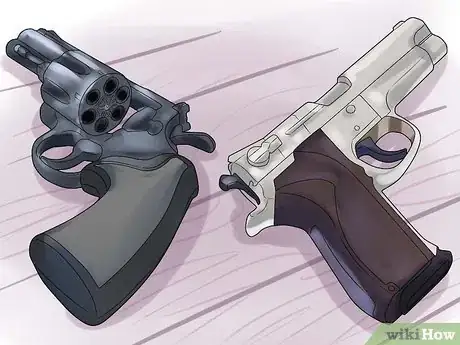
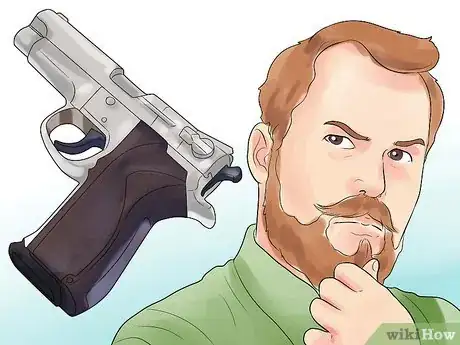


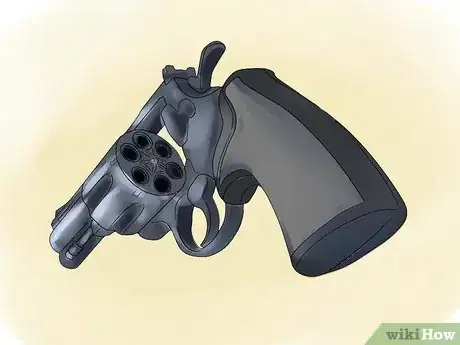
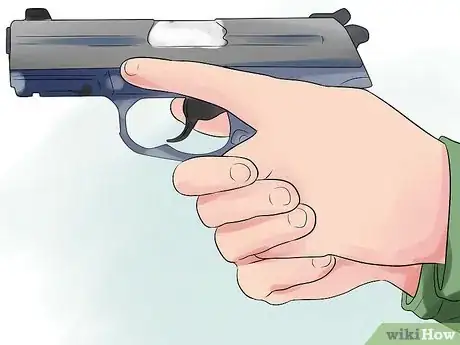
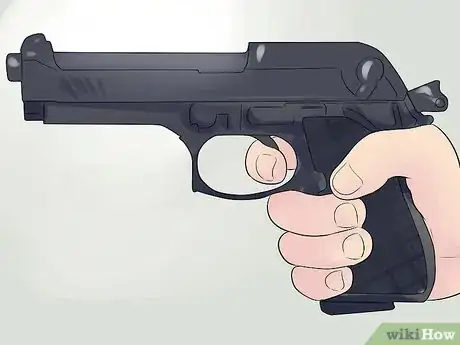
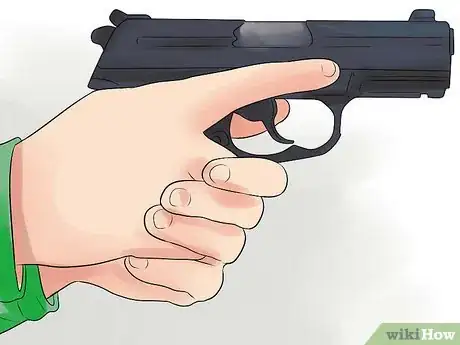
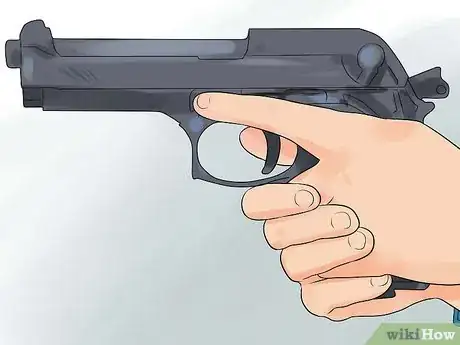

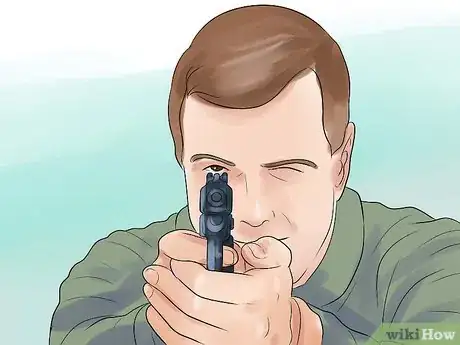
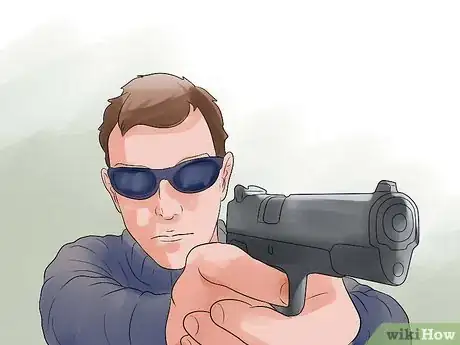
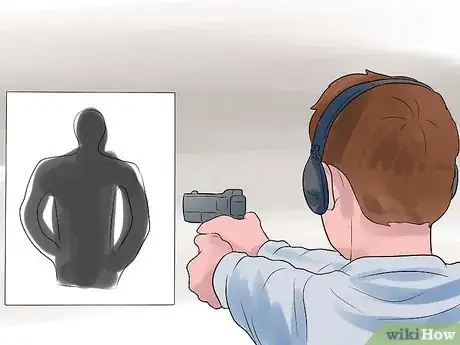

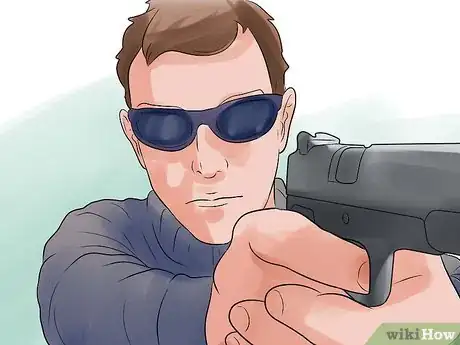
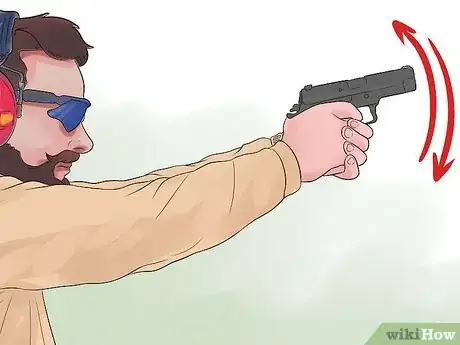
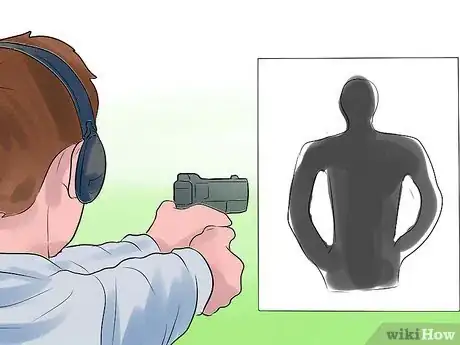
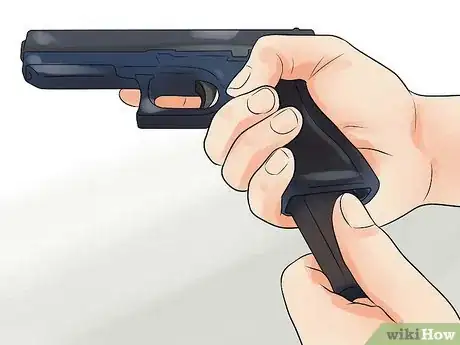

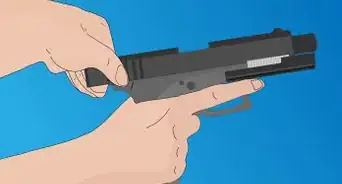
-With-a-Pistol-Step-18.webp)
-Step-21-Version-3.webp)
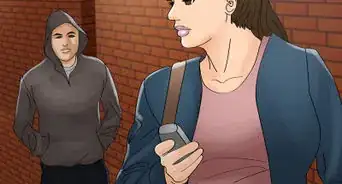
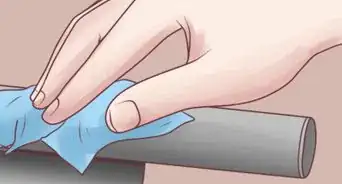
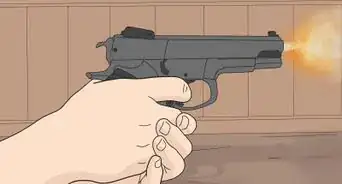
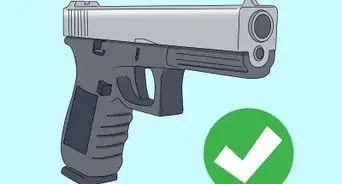
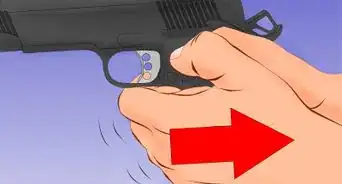



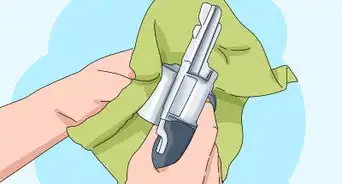
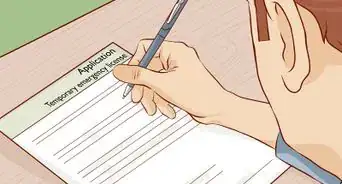












-With-a-Pistol-Step-18.webp)
-Step-21-Version-3.webp)



































